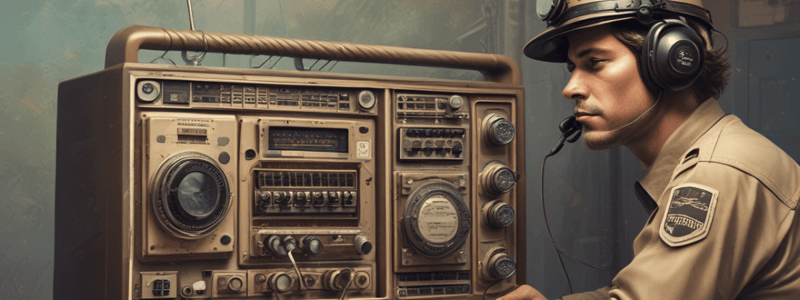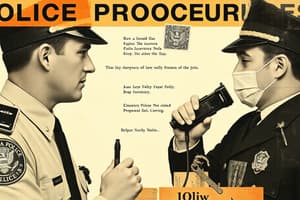Podcast
Questions and Answers
What is the main advantage of using radio codes and signals?
What is the main advantage of using radio codes and signals?
- To be less consistent in radio communications
- To use more airtime
- To make voice transmissions longer
- To have a concise and professional communication (correct)
What is the purpose of using the phonetic-alphabet system?
What is the purpose of using the phonetic-alphabet system?
- To use letters to identify letters in voice communication (correct)
- To use numbers to represent letters
- To use signals to communicate
- To use numeric codes to express meanings
What should you do before transmitting a voice message?
What should you do before transmitting a voice message?
- Speak loudly into the microphone
- Listen to make sure there is no other radio traffic (correct)
- Use a numeric code to express the message
- Press and hold the transmit button for three seconds
What is the purpose of the 10-code system?
What is the purpose of the 10-code system?
What is the main purpose of using alphanumeric codes?
What is the main purpose of using alphanumeric codes?
Why is it important to use proper microphone techniques?
Why is it important to use proper microphone techniques?
What should you do when using a radio in a stressful situation?
What should you do when using a radio in a stressful situation?
What should you do when near a suspect with a radio?
What should you do when near a suspect with a radio?
What type of information can be included in a BOLO?
What type of information can be included in a BOLO?
What is the purpose of issuing a BOLO for an AMBER Alert?
What is the purpose of issuing a BOLO for an AMBER Alert?
What should you do if you arrive at the scene of an incident and need to initiate an immediate BOLO?
What should you do if you arrive at the scene of an incident and need to initiate an immediate BOLO?
What should you do if you do not have enough information on a suspect to initiate a BOLO?
What should you do if you do not have enough information on a suspect to initiate a BOLO?
When should you cancel a BOLO?
When should you cancel a BOLO?
What is the purpose of reviewing information from current BOLOs?
What is the purpose of reviewing information from current BOLOs?
What type of information can be included in a BOLO to help identify a vehicle?
What type of information can be included in a BOLO to help identify a vehicle?
What is the purpose of a BOLO?
What is the purpose of a BOLO?
What is the primary responsibility of the contact officer during an interaction with a suspect?
What is the primary responsibility of the contact officer during an interaction with a suspect?
What is the benefit of having a single officer communicate with the suspect?
What is the benefit of having a single officer communicate with the suspect?
What is the primary responsibility of the cover officer during an interaction with a suspect?
What is the primary responsibility of the cover officer during an interaction with a suspect?
When moving towards a suspect, what should an officer do?
When moving towards a suspect, what should an officer do?
What should an officer do during contact with a suspect?
What should an officer do during contact with a suspect?
What should an officer do if a criminal justice database shows an outstanding warrant for a suspect?
What should an officer do if a criminal justice database shows an outstanding warrant for a suspect?
What should an officer do if the issuing agency waives extradition?
What should an officer do if the issuing agency waives extradition?
What is an important aspect of documenting an officer's actions during an interaction with a suspect?
What is an important aspect of documenting an officer's actions during an interaction with a suspect?
What is the consequence of intentionally causing a false alarm of fire?
What is the consequence of intentionally causing a false alarm of fire?
When documenting a false alarm of fire, what should you include?
When documenting a false alarm of fire, what should you include?
What is the primary goal of responding to an incident involving lost, stolen, or recovered property?
What is the primary goal of responding to an incident involving lost, stolen, or recovered property?
What type of report is used to document lost property incidents?
What type of report is used to document lost property incidents?
Why are precise descriptions of lost property important?
Why are precise descriptions of lost property important?
What should you do when handling lost, stolen, or recovered property?
What should you do when handling lost, stolen, or recovered property?
What type of items are commonly reported as lost property?
What type of items are commonly reported as lost property?
What should you note when documenting lost property?
What should you note when documenting lost property?
What type of situations may require backup officers to respond in emergency mode?
What type of situations may require backup officers to respond in emergency mode?
What should you do upon arrival at the scene to provide backup?
What should you do upon arrival at the scene to provide backup?
Why should backup officers minimize flashlight use?
Why should backup officers minimize flashlight use?
What factors should backup officers consider when determining how to respond to a call?
What factors should backup officers consider when determining how to respond to a call?
What should you do if you are providing backup and the primary officer advises that the situation is under control?
What should you do if you are providing backup and the primary officer advises that the situation is under control?
Why should backup officers stay in communication with the requesting officer?
Why should backup officers stay in communication with the requesting officer?
What is an example of a non-life-threatening situation that may require backup?
What is an example of a non-life-threatening situation that may require backup?
What should you avoid doing while providing backup?
What should you avoid doing while providing backup?
Flashcards
Radio code systems
Radio code systems
Different systems used by agencies for radio communication, including phonetic, numeric, and alphanumeric codes.
Phonetic alphabet
Phonetic alphabet
A system using words to identify letters in voice communication (e.g., A=Alpha).
10-code system
10-code system
A numeric code system using '10' before other numbers for specific meanings (e.g., '10-15' for prisoner in custody).
Alphanumeric code
Alphanumeric code
Signup and view all the flashcards
BOLO
BOLO
Signup and view all the flashcards
Information in BOLO
Information in BOLO
Signup and view all the flashcards
AMBER Alert
AMBER Alert
Signup and view all the flashcards
Establishing communication
Establishing communication
Signup and view all the flashcards
Verifying identity
Verifying identity
Signup and view all the flashcards
Contact officer
Contact officer
Signup and view all the flashcards
Cover officer
Cover officer
Signup and view all the flashcards
Backup officers
Backup officers
Signup and view all the flashcards
Situational awareness
Situational awareness
Signup and view all the flashcards
False alarm of fire
False alarm of fire
Signup and view all the flashcards
Documenting false alarms
Documenting false alarms
Signup and view all the flashcards
Lost property examples
Lost property examples
Signup and view all the flashcards
General information report
General information report
Signup and view all the flashcards
Unique identifiers
Unique identifiers
Signup and view all the flashcards
Responding to backup calls
Responding to backup calls
Signup and view all the flashcards
Circumstances of a BOLO
Circumstances of a BOLO
Signup and view all the flashcards
Observation during contact
Observation during contact
Signup and view all the flashcards
High-risk situations
High-risk situations
Signup and view all the flashcards
Criminal justice databases
Criminal justice databases
Signup and view all the flashcards
Photograph in BOLO
Photograph in BOLO
Signup and view all the flashcards
Vehicle license numbers
Vehicle license numbers
Signup and view all the flashcards
Communication protocol
Communication protocol
Signup and view all the flashcards
Reason for BOLO
Reason for BOLO
Signup and view all the flashcards
Checking for threats
Checking for threats
Signup and view all the flashcards
Study Notes
Radio Communication
- Agencies use different radio code systems, including phonetic-alphabet, numeric or 10-code, and alphanumeric codes.
- Phonetic-alphabet system uses letters of the English alphabet to identify letters in voice communication (e.g., "A" = Alpha, "B" = Bravo).
- Numeric or 10-code system uses the number "10" before other numbers that represent specific activities (e.g., "10-15" often means prisoner in custody).
- Alphanumeric code system combines letters and numbers, including officer call signs or vehicle license plate numbers (e.g., "RVB632" spoken as "Romeo Victor Bravo Six Three Two").
BOLOs (Be On the Lookout)
- A BOLO is a notification to all law enforcement agencies to be on the lookout for a specific suspect, vehicle, or property.
- A BOLO should include as much of the following information as possible:
- Subject's name and identifying information
- Location of the incident
- Reason for the BOLO
- Suspect's last known location and direction of travel
- Description or photograph of the person, vehicle, or property involved
- BOLOs are also issued for AMBER Alerts, Silver Alerts, Blue Alerts, and Purple Alerts.
Initiating Contact and Establishing Communication with a Suspect
- Approach the suspect carefully, keeping a safe distance and observing the suspect's position and body movements.
- Verify the suspect's identity via criminal justice databases and check for outstanding warrants.
- Continuously scan for weapons and possible threats.
Roles of the Contact and Cover Officer
- The contact officer is responsible for leading the approach, handling communication with the suspect, and giving commands and interviews.
- The cover officer is responsible for officer safety concerns, observing the contact officer's interaction with the suspect, and watching for hazards.
Backup Officers
- Backup officers respond to calls for service, providing assistance to other officers in non-life-threatening, high-risk, or life-threatening situations.
- Backup officers should stay in communication with the requesting officer, including visual and verbal contact.
- Upon arrival, survey the scene and maintain situational awareness, minimizing flashlight use to keep others safe on the scene.
False Alarm of a Fire
- A false alarm of a fire is a criminal offense if someone intentionally causes the alarm.
- Document that the suspect, without reasonable cause, circulated a false alarm of fire.
Lost, Stolen, or Recovered Property
- Common lost property includes cell phones, driver's licenses, license plates, credit cards, Social Security cards, and insurance-related claims.
- Use a general information report to document these incidents, getting a description of the property and an estimate of its value.
- Precise descriptions of lost property are important for later identification and recovery, including unique distinguishing identifiers such as scratches or unique parts.
Studying That Suits You
Use AI to generate personalized quizzes and flashcards to suit your learning preferences.





